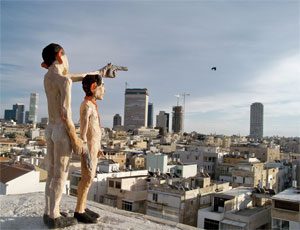With the Kafka cycle, created for the Herzliya Museum of Contemporary Art, März completes a trilogy in which he dealt with writers in the German language and of Jewish origin – with Kafka, considered one of the greatest luminaries of European literature, we find Walter Benjamin, and Hannah Arendt, both his self-proclaimed fans. For the creation of this project März, who lives in Berlin, visited Israel several times over a period of eighteen months, traveling from border to border accompanied by the figures he created and documenting them in fabricated historical scene. Several times he found himself in Kafkaesque situations, some of which found their way into Kafka’s adventures. Through the letters, photographs, songs, clay figures, and paintings, März brings Kafka back to life, sending him on a possible yet fictional biographic journey (despite contemplating the possibility emerging as a result of Kafka’s contacts with intellectuals living in Israel, Kafka himself never came to Israel).
Upon Kafka’s “immigration” to Tel Aviv he undergoes surprising transformations due to the necessity to confront the Israeli reality. As a result of Kafka’s encounter with the Israeli system and society he goes through a variety of physical metamorphoses of androgynous, hybridist, botanic and animalistic nature. These attempts of almost evolutionist adaptation to his surroundings echo the individual’s Kafkaesque pursuit of belonging and assimilating in the system – futile attempts restlessly shifting between various options.
Alongside Kafka runs around his alter ego – the ape Mr. Rotpeter who was abducted from the jungle and became human. The ape, whose freedom was deprived of him, preferred living in a circus (the art world) to living in a zoo (the office). The ape’s transformation into an artist (a decision also made by Kafka himself) signifies for März the only option for successful survival and adaptation to reality, one that preserves the individual’s freedom in the face of national, political institutional systems.
The exhibition was made possible through the support of the Goethe-Institut, Tel Aviv

Less Reading...

